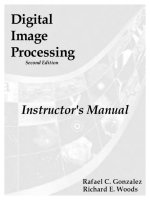Digital Image Processing [GONZALEZ R C WOOD] COVERS
Bạn đang xem bản rút gọn của tài liệu. Xem và tải ngay bản đầy đủ của tài liệu tại đây (2.25 MB, 22 trang )
Digital Image
Processing
Second Edition
Rafael C. Gonzalez
University of Tennessee
Richard E. Woods
MedData Interactive
Prentice Hall
Upper Saddle River, New Jersey 07458
GONZFM-i-xxii. 5-10-2001 14:22 Page iii
Library of Congress Cataloging-in-Pubblication Data
Gonzalez, Rafael C.
Digital Image Processing / Richard E. Woods
p. cm.
Includes bibliographical references
ISBN 0-201-18075-8
1. Digital Imaging. 2. Digital Techniques. I. Title.
TA1632.G66 2001
621.3—dc21 2001035846
CIP
Vice-President and Editorial Director, ECS: Marcia J. Horton
Publisher: Tom Robbins
Associate Editor: Alice Dworkin
Editorial Assistant: Jody McDonnell
Vice President and Director of Production and Manufacturing, ESM: David W. Riccardi
Executive Managing Editor: Vince O’Brien
Managing Editor: David A. George
Production Editor: Rose Kernan
Composition: Prepare, Inc.
Director of Creative Services: Paul Belfanti
Creative Director: Carole Anson
Art Director and Cover Designer: Heather Scott
Art Editor: Greg Dulles
Manufacturing Manager: Trudy Pisciotti
Manufacturing Buyer: Lisa McDowell
Senior Marketing Manager: Jennie Burger
© 2002 by Prentice-Hall, Inc.
Upper Saddle River, New Jersey 07458
All rights reserved. No part of this book may be
reproduced, in any form or by any means,
without permission in writing from the publisher.
The author and publisher of this book have used their best efforts in preparing this book. These efforts
include the development, research, and testing of the theories and programs to determine their
effectiveness. The author and publisher make no warranty of any kind, expressed or implied, with regard to
these programs or the documentation contained in this book. The author and publisher shall not be liable in
any event for incidental or consequential damages in connection with, or arising out of, the furnishing,
performance, or use of these programs.
Printed in the United States of America
10987654321
ISBN: 0-201-18075-8
Pearson Education Ltd., London
Pearson Education Australia Pty., Limited, Sydney
Pearson Education Singapore, Pte. Ltd.
Pearson Education North Asia Ltd., Hong Kong
Pearson Education Canada, Ltd., Toronto
Pearson Education de Mexico, S.A. de C.V.
Pearson Education—Japan, Tokyo
Pearson Education Malaysia, Pte. Ltd.
Pearson Education, Upper Saddle River, New Jersey
GONZFM-i-xxii. 5-10-2001 14:22 Page iv
Contents
Preface xv
Acknowledgements xviii
About the Authors xix
1
Introduction 15
1.1 What Is Digital Image Processing? 15
1.2 The Origins of Digital Image Processing 17
1.3 Examples of Fields that Use Digital Image Processing 21
1.3.1 Gamma-Ray Imaging 22
1.3.2 X-ray Imaging 23
1.3.3 Imaging in the Ultraviolet Band 25
1.3.4 Imaging in the Visible and Infrared Bands 26
1.3.5 Imaging in the Microwave Band 32
1.3.6 Imaging in the Radio Band 34
1.3.7 Examples in which Other Imaging Modalities Are Used 34
1.4 Fundamental Steps in Digital Image Processing 39
1.5 Components of an Image Processing System 42
Summary 44
References and Further Reading 45
2
Digital Image Fundamentals 34
2.1 Elements of Visual Perception 34
2.1.1 Structure of the Human Eye 35
2.1.2 Image Formation in the Eye 37
2.1.3 Brightness Adaptation and Discrimination 38
2.2 Light and the Electromagnetic Spectrum 42
2.3 Image Sensing and Acquisition 45
2.3.1 Image Acquisition Using a Single Sensor 47
2.3.2 Image Acquisition Using Sensor Strips 48
2.3.3 Image Acquisition Using Sensor Arrays 49
2.3.4 A Simple Image Formation Model 50
2.4 Image Sampling and Quantization 52
2.4.1 Basic Concepts in Sampling and Quantization 52
2.4.2 Representing Digital Images 54
2.4.3 Spatial and Gray-Level Resolution 57
2.4.4 Aliasing and Moiré Patterns 62
2.4.5 Zooming and Shrinking Digital Images 64
vii
GONZFM-i-xxii. 5-10-2001 14:22 Page vii
2.5 Some Basic Relationships Between Pixels 66
2.5.1 Neighbors of a Pixel 66
2.5.2 Adjacency, Connectivity, Regions, and Boundaries 66
2.5.3 Distance Measures 68
2.5.4 Image Operations on a Pixel Basis 69
2.6 Linear and Nonlinear Operations 70
Summary 70
References and Further Reading 70
Problems 71
3
Image Enhancement in the Spatial Domain 75
3.1 Background 76
3.2 Some Basic Gray Level Transformations 78
3.2.1 Image Negatives 78
3.2.2 Log Transformations 79
3.2.3 Power-Law Transformations 80
3.2.4 Piecewise-Linear Transformation Functions 85
3.3 Histogram Processing 88
3.3.1 Histogram Equalization 91
3.3.2 Histogram Matching (Specification) 94
3.3.3 Local Enhancement 103
3.3.4 Use of Histogram Statistics for Image Enhancement 103
3.4 Enhancement Using Arithmetic/Logic Operations 108
3.4.1 Image Subtraction 110
3.4.2 Image Averaging 112
3.5 Basics of Spatial Filtering 116
3.6 Smoothing Spatial Filters 119
3.6.1 Smoothing Linear Filters 119
3.6.2 Order-Statistics Filters 123
3.7 Sharpening Spatial Filters 125
3.7.1 Foundation 125
3.7.2 Use of Second Derivatives for Enhancement–
The Laplacian 128
3.7.3 Use of First Derivatives for Enhancement—The Gradient 134
3.8 Combining Spatial Enhancement Methods 137
Summary 141
References and Further Reading 142
Problems 142
4
Image Enhancement in the Frequency
Domain 147
4.1 Background 148
viii
■
Contents
GONZFM-i-xxii. 5-10-2001 14:22 Page viii
![Digital Image Processing [GONZALEZ R C WOOD] COVERS](https://media.store123doc.com/images/document/12/ve/qx/medium_iRRrjvO18Y.jpg)








